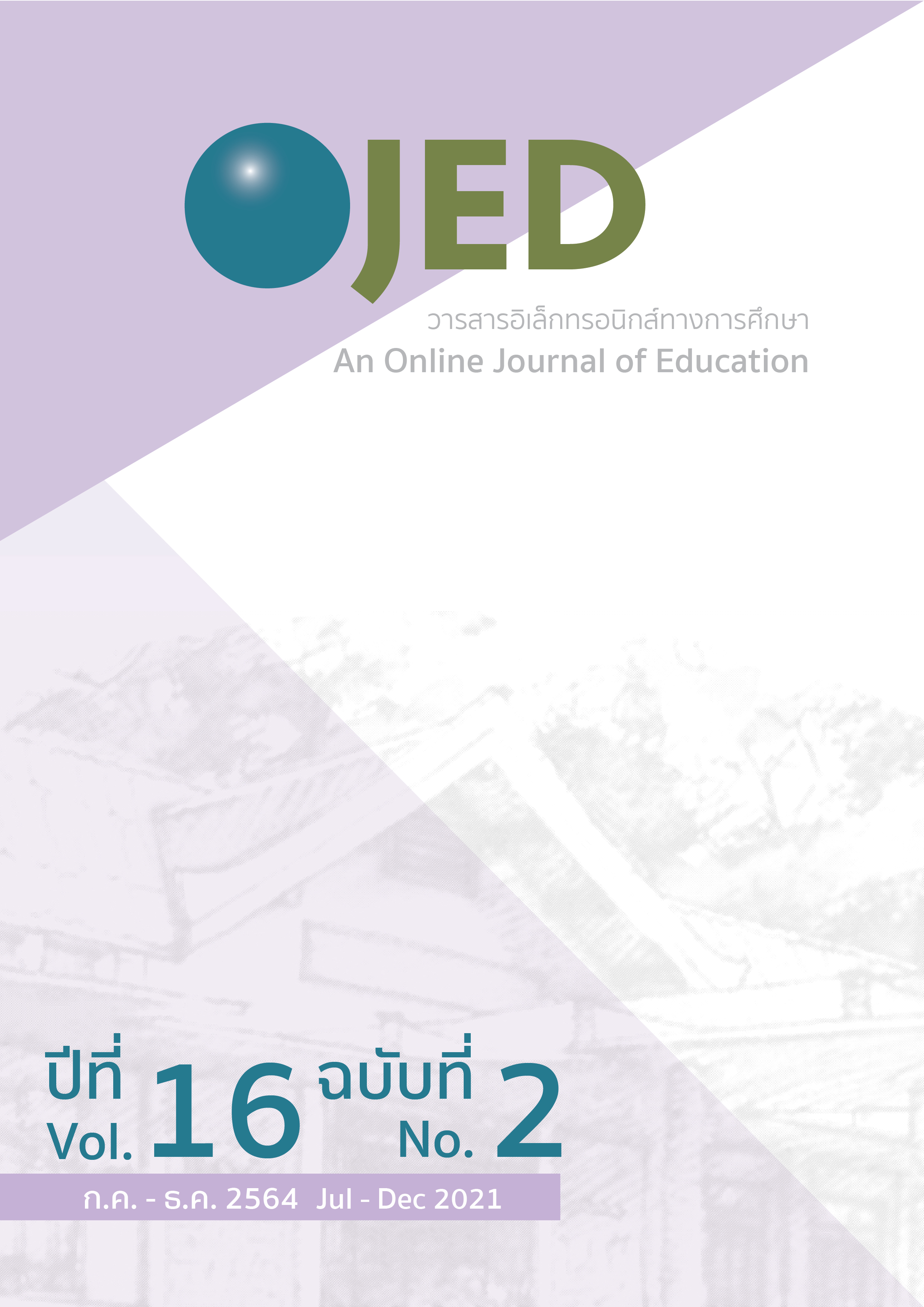Guidelines for Using Online Social Network in a Studio Art Program of Undergraduate Students
DOI:
https://doi.org/10.14456/ojed.2021.63Keywords:
studio art program, guidelines, online social network, undergraduate studentAbstract
The objective of this study was to propose guidelines for using appropriate social network to facilitate studio art program. The samples of this study were consisted of 22 studio art teachers and 360 students from 8 universities, which were Chulalongkorn University, Srinakharinwirot University, Chiang Mai University, Khon Kaen University, Burapha University, Prince of Songkla University, Ramkhamhaeng University, and Bansomdejchaopraya Rajabhat University. The instruments used in this study were interview form, questionnaire, and observation form. The quantitative data was analysed by calculating percentage, mean, and standard deviation. The interview and observation data were analysed by using content analysis. The results showed that integrating social network into studio art program increased class learning efficiency, minimized time and space limitation, increased student learning and research channel, and encouraging idea and development. 1) For develop craft, the most appropriate social network is content community. 2) For engage & persist, the most appropriate type of social network is social networking site or SNS. 3) Every type of social network can be used to develop envision and inspiration. 4) To express the idea and expression, the most appropriate type of social network is SNS. 5) To observe, the most appropriate social network is SNS 6) Blog is the most appropriate type for stretch & explore. And 7) to understand art world, Blog is the most appropriate type of social network. Teachers have the very important roles in advising student how to learn, research, and using social network appropriately.
References
เกศริน แสงจันทร์เรือง. (2554). การใช้เครือข่ายสังคมออนไลน์เพื่อส่งเสริมและพัฒนาการเรียนรู้ทางสังคม (กรณีศึกษา: การใช้ facebook.com ของนักศึกษามหาวิทยาลัยธรรมศาสตร์) [วิทยานิพนธ์ปริญญามหาบัณฑิต ไม่ได้ตีพิมพ์]. มหาวิทยาลัยธรรมศาสตร์.
เจมส์ เบลลันกา และ รอนแบรนต์. (2556). ทักษะแห่งอนาคตใหม่ : การศึกษาเพื่อศตวรรษที่ 21 (พิมพ์ครั้งที่ 2). โอเพ่นเวิลด์ส.
ชลูด นิ่มเสมอ. (2529). องค์ประกอบของศิลปะ. เดียนสโตร์.
แผนแม่บทเทคโนโลยีสารสนเทศและการสื่อสารเพื่อการศึกษากระทรวงศึกษาธิการ พ.ศ.2554-2556. (2556). สำนักงานปลัดกระทรวงศึกษาธิการ. http://www.moe.go.th/moe/th/news/detail.php?NewsID=32036&Key=news20
ไพฑูรย์ สินลารัตน์. (2525). ปรัชญาแห่งจุดมุ่งหมายของการอุดมศึกษา. คณะครุศาสตร์ จุฬาลงกรณ์มหาวิทยาลัย.
ไพฑูรย์ สินลารัตน์. (2556). การศึกษาไทย 4.0: การศึกษาเชิงสร้างสรรค์และผลิตภาพ. วิทยาลัยครุศาสตร์ มหาวิทยาลัยธุรกิจบัณฑิต.
ไพฑูรย์ สินลารัตน์. (2557). ทักษะแห่งศตวรรษที่21: ต้องก้าวให้พ้นกับดักของตะวันตก. วิทยาลัยครุศาสตร์ มหาวิทยาลัยธุรกิจบัณฑิต.
ยืน ภู่วรวรรณ และ สมชาย นำประเสริฐชัย. (2546). ไอซีทีเพื่อการศึกษาไทย. ซีเอ็ดยูเคชั่น.
วิทยากร เชียงกูล. (2542). รายงานสภาวะการศึกษาไทย ปี 2541 : วิกฤติและโอกาสในการปฎิรูปการศึกษา และสังคมไทย (พิมพ์ครั้งที่ 2). อมรินพริ้นติ้งแอนด์พับลิชชิ่ง.
สุมาลี ชัยเจริญ. (2545). แนวโน้มของการวิจัยสื่อทางปัญญา. ภาควิชาเทคโนโลยีทางการศึกษา คณะศึกษาศาสตร์ มหาวิทยาลัยขอนแก่น.
เอกชัย พุทธสอน. (2557). แนวโน้มการเสริมสร้างทักษะการเรียนรู้ในศตวรรษที่ 21 สำหรับนักศึกษาผู้ใหญ่. OJED, 9 (4), 93-106.
Ajjan, H. & Hartshorne, R. (2008). Investigating faculty decisions to adopt Web 2.0 technologies: theory and empirical tests. The Internet and Higher Education, 11(2), 179-211.
Bellanca, J. & Brandt, R. (2010). 21st Century Skills: Rethinking How Students Learn. Solution Tree Press.
Dobbs, S. M. (1998). Learning in and through art: A guide to discipline-base art education. Getty Education Institute for the Arts.
Gregory, D. (2009). Box with fires: Wisely integrating learning technologies into the Art Classroom. Art Education, 62(3), 47-54.
Hetland, L. et al. (2007) Studio thinking: The real benefits of visual arts education. Teachers College Press.
Kaplan, A.M. and Haenlein, M. (2010). Users of the world, unite! The challenges and opportunities of Social Media. Business Horizons. 53, 59-68.
Mason, R. (2006). Learning technologies for adult continuing education. Studies in Continuing Education, 28(2), 121-133.
Read, H. (1984). The Meaning of Art. Faber & Faber.
Bosman, L. and Zagenczyk, T. (2011). Revitalize your teaching: Creative approaches to applying social media in the classroom. Springer.
Poore, M. (2013). Using social media in the classroom. SAGE.
Downloads
Published
How to Cite
Issue
Section
License

This work is licensed under a Creative Commons Attribution-NonCommercial-NoDerivatives 4.0 International License.




